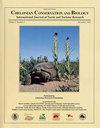对黑人生存水平的剥削和一个可行的选择
IF 0.8
4区 生物学
Q3 ZOOLOGY
引用次数: 6
摘要
在亚马逊河第三大支流里约热内卢Negro,许多海龟物种几个世纪以来一直是该地区人类重要的商业和蛋白质资源。多年来,这一直是一种可持续的活动,但如今,由于狩猎压力的增加,亚马逊地区海龟种群的前景并不乐观。基于在亚马逊地区20年的保护工作,我们报告了该地区海龟种群面临的压力,并报告了在里约热内卢Negro地区开发的可持续的龟类开发替代方案。我们描述了材料和手工加工的工匠使用,将自然资源转化为艺术品。基于这个社区项目模型,我们讨论了目前政府对里约热内卢Negro当地社区的支持,并提供了在亚马逊地区应用这种替代海龟商业化的经济选择的见解。本文的研究成果可直接应用于巴西的环境管理者、非政府组织和政策制定者,旨在呼吁政府和环境管理者促进亚马逊地区的海龟保护,确保当地社区的经济安全。本文章由计算机程序翻译,如有差异,请以英文原文为准。
Subsistence-Level Chelonian Exploitation on the Rio Negro and One Viable Alternative
Abstract In the Rio Negro, the third-largest tributary of the Amazon, many turtle species have been important commercial and protein resources for centuries for populations of humans living in the region. For many years, this had been a sustainable activity, but nowadays the outlook for turtle populations in the Amazon is unfavorable due to increasing hunting pressure. Based on 20 yrs of conservation work in the Amazon, we report on the pressure faced by turtle populations in the area and report a sustainable chelonian exploitation alternative developed in the Rio Negro region. We describe the materials and the hand processing artisans use to transform natural resources into artworks. Based on this community program model, we discuss the current government support to local communities of the Rio Negro and provide insights on the application of this economic alternative to substitute for turtle commercialization in the Amazon. The outcomes of this manuscript have direct applications for environmental managers, nongovernmental organizations, and policymakers in Brazil and aim to call government and environmental managers to promote turtle conservation in the Amazon, securing economic safety for local communities.
求助全文
通过发布文献求助,成功后即可免费获取论文全文。
去求助
来源期刊
CiteScore
1.70
自引率
14.30%
发文量
17
审稿时长
>12 weeks
期刊介绍:
Chelonian Conservation and Biology is a biannual peer-reviewed journal of cosmopolitan and broad-based coverage of all aspects of conservation and biology of all chelonians, including freshwater turtles, marine turtles, and tortoises. Manuscripts may cover any aspects of turtle and tortoise research, with a preference for conservation or biology. Manuscripts dealing with conservation biology, systematic relationships, chelonian diversity, geographic distribution, natural history, ecology, reproduction, morphology and natural variation, population status, husbandry, community conservation initiatives, and human exploitation or conservation management issues are of special interest.

 求助内容:
求助内容: 应助结果提醒方式:
应助结果提醒方式:


